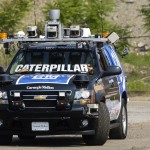 Drivers Wanted Download PDF
Drivers Wanted Download PDF
It is already possible to build driverless cars, trucks and buses. But practical problems and safety concerns mean they may never be allowed on the roads.
The teams competing in DARPA’s Grand Challenge (see article) have it easy. The driverless vehicles racing off-road in the Mojave Desert merely have to avoid boulders, dunes and the occasional cactus. That is nothing compared with the hazards of the open road. Put those same autonomous vehicles on Interstate 15—the busy road that links Los Angeles and Las Vegas—and they would also have to contend with bleary-eyed weekenders, huge trucks and octogenarians puttering along in mobile homes. Even so, engineers and scientists at a handful of academic and industrial research centres are valiantly grappling with the problem of designing autonomous passenger vehicles, buses and trucks. They imagine a future in which convoys of cars would communicate with each other and with roadside sensors to navigate congested freeways, ensure smooth traffic flow and virtually eliminate accidents.
The first fleet of autonomous cars emerged from the Automated Highway System (AHS) programme funded by America’s transport department in the 1990s. After spending $14m, AHS researchers showed off their handiwork in 1997. They implanted 92,000 guidance magnets along a closed seven-mile stretch of motorway near San Diego, California and then released more than a dozen vehicles on to the road. But while the cars performed flawlessly, the programme was cancelled in 1998.
The development of autonomous vehicles has not skidded to a halt, however. In some respects, the technology is quietly sneaking into cars already. Carmakers are starting to incorporate radar-based sensors, micro-cameras and intelligent cruise-control systems—all of which were once limited to research vehicles—into their luxury models. As such equipment becomes more widespread, it could make retrofitting cars for autonomous operation far cheaper and easier.
The technology has also migrated into “group” transit systems. These are small-scale automated transports designed as affordable alternatives to light-rail networks, since they run on cheap roads rather than costly rails. FROG Navigation Systems of Utrecht in the Netherlands, for example, makes an autonomous control system that can be integrated into just about any vehicle. FROG—an acronym for “free ranging on grid”—uses magnets embedded in the road as reference points. Front-mounted radar scans for obstacles, triggering the brakes if needed. It is elegant and simple, and it works: FROG’s ParkShuttle whisks passengers from car parks at Amsterdam’s Schiphol airport to the terminal building. Even more impressive is the CyberCab, a driverless taxi that can carry riders to designated locations at the press of a button.
Autonomous vehicle technology is also attracting interest from the trucking industry which is especially intrigued by the idea of “platooning”. Commercial trucks often travel along the same regular routes. As a cost-cutting measure, platooning would allow haulage firms to arrange trucks in tight convoys and eliminate drivers in all but the lead vehicle. Braking, gear-shifting and steering commands in the lead truck would be beamed via a wireless connection—called an electronic tow-bar—to the trailing vehicles. The result would be a serpent-like conga-line rumbling down the highway. Chauffeur, a European joint-venture funded by DaimlerChrysler, Iveco, Bosch and others, has demonstrated the technique on Iveco’s proving grounds in Balocco, Italy.
But truck platoons are not going to appear on public roads any time soon, reckons Karl Hedrick, an engineer at the University of California at Berkeley. He spent several years developing AHS technologies in the mid-1990s and points out that it is a wary public—rather than inadequate technology—that is ultimately hindering the widespread introduction of autonomous vehicles. Chauffeur’s test runs went off without a hitch. But who wants to share the road with an army of 40-tonne driverless lorries?
A more realistic approach for the convoys, suggests Dr. Hedrick, would be to designate special platooning lanes, separated by fixed barriers. Then, as drivers become comfortable with the technology and see that it is safe, they might be willing to consider platooning in their own cars. But there is still the problem of managing the formation and dispersal of platoons as cars join and leave, notes Dr. Hedrick. If one car needs to refuel, it seems silly for the entire platoon to stop.
Platoons might be safer than individual cars and allow roads to be used more efficiently, but they require drivers to give up their autonomy. For many drivers, that may prove too high a price. In America, in particular, the open road is associated with freedom. A dozen cars coupled into a half-mile-long motorcade, in contrast, sounds an awful lot like a train.
Copyright © Michael Behar. All Rights Reserved.
